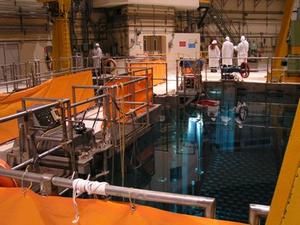Nuclear terrorismRisks of terrorists attacking, or using materials from, a nuclear power plant are low: Experts
Energy analysts who support new nuclear power plants construction insist that the probability of a terrorist nuclear attack by land, sea, or air is extremely low. They reject arguments by nuclear power opponents that terrorist groups may one day attack a nuclear plant, or build an improvised nuclear bomb using materials stolen from a nuclear power plant – and that governments should, therefore, end construction of new nuclear power plants. Climate scientists supporting reduction in CO2 emissions wrote that “There is no credible path to climate stabilization that does not include a substantial role for nuclear power.”

Spent fuel in a storage tank // Source: wikipedia.org
Energy analysts who support new nuclear power plants construction insist that the probability of a terrorist nuclear attack by land, sea, or air is extremely low. They reject arguments by nuclear power opponents that terrorist groups may one day attack a nuclear plant, or build an improvised nuclear bomb using materials stolen from a nuclear power plant – and that governments should, therefore, end construction of new nuclear power plants. A recent article published by The Energy Collective examines the probability and real hazard of a terrorist attack on a nuclear plant, and the hazards and probabilities of other available nuclear attack options for terrorists.
Terrorist organizations may attack a nuclear plant to prompt a meltdown, but a nuclear meltdown from a reactor may result in less damage than most terrorist groups aspire to inflict. The standard radiation dose limit for workers near the Fukushima Daiichi nuclear disaster was 50 millisievert (msv) per year and 100 msv over five years, but in order to allow workers to respond to the accident, the emergency dose was increased to 250 msv per year from 100 msv per year pre-meltdown. One-hundred-and-seventy-six workers at the plant received doses of between 100 and 670 msv during and shortly after the disaster (msv), but only two workers died from the incident.
Attempts to steal nuclear materials for use in an improvised nuclear bomb from nuclear power plants are likely to fail because the radioactive materials, such as spent fuel rods in nuclear power plants, are effectively untransportable due to “the heat generated by large quantities of such material and the extreme exposure hazard from the intensity of the radiation.” Individuals attempting to steal spent fuel rods would be exposed to dangerous radiation levels and are likely to die or fall seriously ill before they could have the chance to use the materials. Additionally, fuel stolen from a reactor might be poorly enriched, making it relatively useless for an improvised nuclear weapon. Robert Frost, president of Nuclear Safety Associates, noted in a 2005 Adelphi Papers that constructing the device itself is practically impossible for terrorist groups, considering the need for advanced equipment, expertise, and facility. Furthermore, the materials considered most practical for use in improvised nuclear bombs, as The Homeland Security News Wire reported earlier this year, are used in medical applications, far from any nuclear plant.
The probability of an intrusion of a Western nuclear power plant is extremely low due to intense physical and electronic security. “There has never been [a terrorist attack on a nuclear plant], and there appears to be no evidence that a plan to attack a nuclear power plant has ever moved beyond the basic planning phase in any terrorist group,” said Robert Wilson, an energy analyst. The only reported successful intrusions of a working nuclear facility have been led by activists who sought to send anti-nuclear messages.
Opponents of new nuclear plants construction have claimed that terrorists could one day crash a jumbo jet loaded with fuel into a nuclear plant’s containment dome. Engineers at Entergy, the operator of New York’s Indian Point power plant, are confident that a dome’s three to six feet concrete walls reinforced with embedded steel bars and a half-inch steel liner could withstand a collision with a large airliner. Should a fire ignite after a jumbo jet collides with a plant’s containment dome, a 2006 review by the U.S. Nuclear Regulatory Commission to Congress concluded that the “likelihood of both damaging the reactor core and releasing radioactivity that could affect public health and safety is low.”
The risk of not building more nuclear power plants means an increasing reliance on fossil fuel which remains a major contributor to climate change. While alternative energy sources like wind and solar have gained popularity, “those energy sources cannot scale up fast enough to deliver cheap and reliable power at the scale the global economy requires,” wrote climate scientists Kenneth Caldeira of the Carnegie Institution, Kerry Emanuel at the Massachusetts Institute of Technology, James E. Hansen of Columbia University, and Tom Wigley of the National Center for Atmospheric Research and the University of Adelaide, in a letter to anti-nuclear power policy makers responsible for environmental policy. “There is no credible path to climate stabilization that does not include a substantial role for nuclear power,” the scientists added (see “Climate scientists say renewables are not enough,” HSNW, 13 November 2013; and “Leading climate scientists urge support for nuclear power,” HSNW, 5 November 2013).
